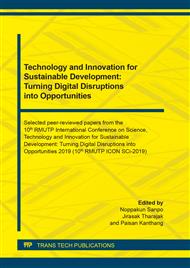[1]
E. Onofrei, A.M. Rocha and A. Catarino, Investigating the effect of moisture on the thermal comfort properties of functional elastic fabrics. J. Ind. Text. 42(1) (2012) 34-51.
DOI: 10.1177/1528083711425840
Google Scholar
[2]
M.J. Pac, M. Bueno and M. Renner, Warm-cool feeling relative to tribological properties of fabrics. Text. Res. J. 71(9) (2001) 806-812.
DOI: 10.1177/004051750107100910
Google Scholar
[3]
M. Sampath, S. Mani and G. Nalankilli, Effect of filament fineness on comfort characteristics of moisture management finished polyester knitted fabrics. J. Ind. Text. 41(2) (2011) 160-173.
DOI: 10.1177/1528083711400774
Google Scholar
[4]
W.E. Morton., J.W.S. Hearle, Physical Properties of Textile Fibers, Woodhead Publishing, Cambridge, (2008).
Google Scholar
[5]
L. Hes, Optimisation of shirt fabrics' composition from the point of view of their appearance and thermal comfort. Int. J. Cloth. Sci. Technol. 11(2/3) (1999) 105-119.
DOI: 10.1108/09556229910276250
Google Scholar
[6]
J. Dargahi and S. Najarian, Human tactile perception as a standard for artificial tactile sensing – a review. Int. J. Med. Robot. Comp. Assist. Surg. 1(1) (2004) 23-35.
DOI: 10.1002/rcs.3
Google Scholar
[7]
G. Havenith, Interaction of clothing and thermoregulation. Exogenous Dermatol. 1(5) (2002), 221-230.
DOI: 10.1159/000068802
Google Scholar
[8]
N. Oglakcioglu and A. Marmarali, Thermal comfort properties of some knitted structures, Fib. Text. Eastern Euro. 15 (2007) 94-96.
Google Scholar
[9]
A. Ali, A. Sheraz, R. Abher, A. Faheem, I. Fatima and N. Yasir, Influence of fabric parameters on thermal comfort performance of double layer knitted interlock fabrics, AUTEX Res. J. 17(1) (2017) 20-26.
DOI: 10.1515/aut-2015-0037
Google Scholar
[10]
S.K. Chinta and P.D. Gujar, Significance of moisture management for high performance textile fabrics, Int. J. Inno. Res. Sci. Eng. Technol. 2(3) (2013) 814-819.
Google Scholar
[11]
B. Das, A. Das, V. Kothari, R. Fanguiero and M. Araújo, Moisture transmission through textiles Part I: processes involved in moisture transmission and the factors at play. AUTEX Res. J. 7(2) (2007) 100-110.
Google Scholar
[12]
A. Majumdar, S. Mukhopadhyay and R. Yadav, Thermal properties of knitted fabrics made from cotton and regenerated bamboo cellulosic fibres. Int. J. Therm. Sci. 49(10) (2010) 2042-2048.
DOI: 10.1016/j.ijthermalsci.2010.05.017
Google Scholar
[13]
N. Ozdil, A. Marmarah and S.D. Kretzschmar, Effect of yarn properties on thermal comfort of knitted fabrics. Int. J. Therm. Sci. 46 (2007) 1318–1322.
DOI: 10.1016/j.ijthermalsci.2006.12.002
Google Scholar


